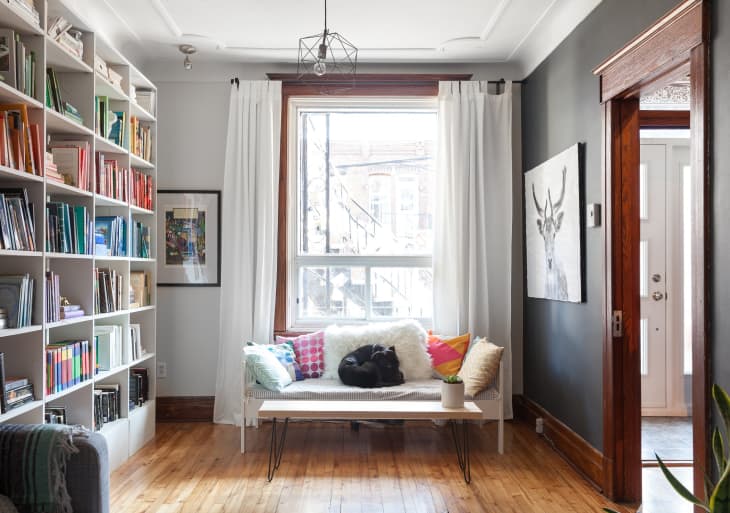5 Inspiring Examples of Pipes as Curtain Rods

In my many years of living in apartments and houses that tend to include windows (ok, they have all had windows), I’ve long found myself underwhelmed by curtain rods. If I do what’s practical and just buy something affordable, the materials yield an almost hilariously flimsy product. If I squirrel away extra dollars for significantly higher quality curtain rods, I seem to suffer decision fatigue on exactly where to purchase them (after all, you don’t want to spend a wad of cash on something so innocuous only to find yourself second-guessing your choice in the end).
While I’m a big fan of vintage-accented rods (think old crystal), I also badly wanted to bring a small bit of an industrial feel into my new home in Portland, Oregon. Industrial can be a bit of a misfit aesthetic when not in a warehouse-type neighborhood (I am not), but I found a way to make it work subtly with this one simple design replacement: Use a pipe instead of a curtain rod.
I chose to use pipe fittings to anchor the pipe to the wall, but that’s not the only way to do it. The biggest downside to using this method instead of a traditional curtain rod is that I’ll have to exert a little more effort when it’s time to remove my curtains to wash them, but we’re talking only a few minutes every once in a blue moon. For me, it was worth the tiny additional hassle. (Side note: You can avoid this by choosing curtains that can be removed without disassembling the pipe, like ones with Velcro, snap, or button closings—or ones that hang from a pipe with cute rings.)
These kinds of details in homes are often what set good design schemes apart from the great ones. A little creativity can go a long way toward taking your space to the next level. If you want to try it for yourself, use these easy steps to pull it all together:
1. Get your supplies. Depending on the look you choose, you may need an elbow, close nipple, and floor flange in addition to your pipe (those are the parts I used). Make sure you measure your window in advance so you can be purchase a pipe that is at least a little bigger than your window.
2. Prep your pipe. If you go with a galvanized pipe like I did, you’re going to want to make sure you get any excess grease and grime off of the pipe first. You can use something like Goo Gone for this to make sure your cleaning job is thorough. You’ll want to do the same thing to your other parts if you choose galvanized steel elbows, for example.
3. Now’s the time to paint. Instead of painting my pipe, I used a couple different shades of gray steel. However, you can easily spray paint these parts if you want a gold or teal (or whatever!) finish, and now would be the time to do that if so.
4. Assemble your rod and elbows. The length will be a little bit longer than the pipe itself once you add the elbow to it. Put the elbows on the pipe in advance so you have an accurate idea of its length.
5. Make your markings. Once you know the length of the pipe curtain rod, carefully measure and make light marks with pencil for where you’d like the flanges to screw into the wall.
6. Attach the flanges to the wall. You’ll want to drill and insert drywall anchors to keep the entire ensemble steady.
7. Finish up. Once the flanges are in, wrapping up this project is easy. You just need to attach a nipple and elbow to one flange, carefully add your curtain, and then attach a nipple and elbow to the other flange. Note: you might need a second pair of hands for this part.
Pro tip: Select an extra long pipe like I did. You’ll save yourself the hassle of having to cut a pipe, first of all, and, secondly, if you extend your curtains out when they’re open all the way to the edges of your window, it will give the illusion of a much wider window, which I like. Plus, pipes are pretty cheap. My entire project was around $20 in materials. Here’s what it looks like:
And with curtains…
But there are tons of inspiring examples all over the Internet. Here are some of our favorites to help get you dreaming and motivated:
Shiny Copper Pipe
Blend copper hues for this look that we love. Complete it with some copper rings.
Glass Doorknob
This creative person combined my two favorite curtain rod aesthetics – an industrial pipe and vintage crystal – to make a one-of-a-kind solution.
Gold Pipe
Go for the gold by emulating this pipe-as-curtain-rod look.
Mixing Colors and Metals
Don’t be afraid to combine colors and metal tones! When played right, it’s an excellent look.